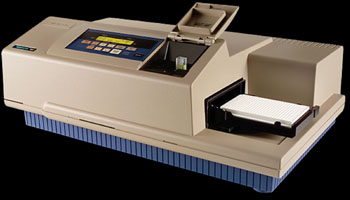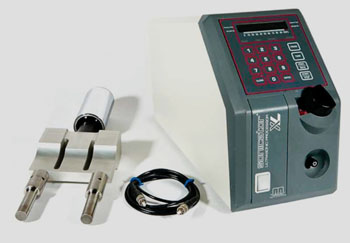Enzyme Assay on Impregnated Filter Paper Detects Krabbe Disease
|
By LabMedica International staff writers Posted on 26 Jan 2015 |

Image: The SpectraMax M2 spectrofluorometer (Photo courtesy of Molecular Devices).

Image: The Misonix Sonicator XL2020 (Photo courtesy of Qsonica).
Krabbe disease (KD) is an inherited lysosomal storage disease (LSD) caused by the deficiency of galactocerebrosidase (GALC) and is characterized by a severe and progressive leukodystrophy with death frequently before one year of life.
Dried-blood filter paper (DBFP) samples have been increasingly used for lysosomal enzyme assay and some lysosomal enzymes could not be tested in DBFP samples using fluorometric assays, including GALC, heparan-sulfamidase and a few others.
Medical Geneticists at the Hospital de Clínicas de Porto Alegre (Brazil) obtained leucocytes from healthy individuals and confirmed KD patients. Dried-leukocytes filter paper (DLFP) samples were prepared by diluting a pellet of leukocytes in distilled water and the solution was mixed, sonicated on ice bath in a Misonix Sonicator XL2020 (Qsonica; Newtown, CT, USA). After incubation with suitable substrates supernatants were measured on SpectraMax M2 spectrofluorometer (Molecular Devices; Sunnyvale, CA, USA).
When GALC activities in DLFP and their corresponding leukocyte samples were compared, it is possible to see a close correlation in the respective KD groups. The healthy control group showed higher values of activities in DLFP, possibly due to some degree of protein retention in the filter paper in the dilution process. The investigators did not visualize this effect in the KD samples, probably because the fluorescence of these samples is very low. Nevertheless, the assay in DLFP allowed the correct identification of KD patients in all cases.
The authors concluded that the assay of GALC on DLFP is a reliable and useful method for the identification of KD. As sample preparation is feasible in standard biochemical laboratories and as transportation is very simple, it could enable patients living in remote areas to be investigated and diagnosed. The study was published on January 1, 2015, in the journal Clinica Chimica Acta.
Related Links:
Hospital de Clínicas de Porto Alegre
Qsonica
Molecular Devices
Dried-blood filter paper (DBFP) samples have been increasingly used for lysosomal enzyme assay and some lysosomal enzymes could not be tested in DBFP samples using fluorometric assays, including GALC, heparan-sulfamidase and a few others.
Medical Geneticists at the Hospital de Clínicas de Porto Alegre (Brazil) obtained leucocytes from healthy individuals and confirmed KD patients. Dried-leukocytes filter paper (DLFP) samples were prepared by diluting a pellet of leukocytes in distilled water and the solution was mixed, sonicated on ice bath in a Misonix Sonicator XL2020 (Qsonica; Newtown, CT, USA). After incubation with suitable substrates supernatants were measured on SpectraMax M2 spectrofluorometer (Molecular Devices; Sunnyvale, CA, USA).
When GALC activities in DLFP and their corresponding leukocyte samples were compared, it is possible to see a close correlation in the respective KD groups. The healthy control group showed higher values of activities in DLFP, possibly due to some degree of protein retention in the filter paper in the dilution process. The investigators did not visualize this effect in the KD samples, probably because the fluorescence of these samples is very low. Nevertheless, the assay in DLFP allowed the correct identification of KD patients in all cases.
The authors concluded that the assay of GALC on DLFP is a reliable and useful method for the identification of KD. As sample preparation is feasible in standard biochemical laboratories and as transportation is very simple, it could enable patients living in remote areas to be investigated and diagnosed. The study was published on January 1, 2015, in the journal Clinica Chimica Acta.
Related Links:
Hospital de Clínicas de Porto Alegre
Qsonica
Molecular Devices
Latest Technology News
- New Diagnostic System Achieves PCR Testing Accuracy
- DNA Biosensor Enables Early Diagnosis of Cervical Cancer
- Self-Heating Microfluidic Devices Can Detect Diseases in Tiny Blood or Fluid Samples
- Breakthrough in Diagnostic Technology Could Make On-The-Spot Testing Widely Accessible
- First of Its Kind Technology Detects Glucose in Human Saliva
- Electrochemical Device Identifies People at Higher Risk for Osteoporosis Using Single Blood Drop
- Novel Noninvasive Test Detects Malaria Infection without Blood Sample
- Portable Optofluidic Sensing Devices Could Simultaneously Perform Variety of Medical Tests
- Point-of-Care Software Solution Helps Manage Disparate POCT Scenarios across Patient Testing Locations
- Electronic Biosensor Detects Biomarkers in Whole Blood Samples without Addition of Reagents
- Breakthrough Test Detects Biological Markers Related to Wider Variety of Cancers
- Rapid POC Sensing Kit to Determine Gut Health from Blood Serum and Stool Samples
- Device Converts Smartphone into Fluorescence Microscope for Just USD 50
- Wi-Fi Enabled Handheld Tube Reader Designed for Easy Portability
Channels
Molecular Diagnostics
view channelBlood Proteins Could Warn of Cancer Seven Years before Diagnosis
Two studies have identified proteins in the blood that could potentially alert individuals to the presence of cancer more than seven years before the disease is clinically diagnosed. Researchers found... Read moreUltrasound-Aided Blood Testing Detects Cancer Biomarkers from Cells
Ultrasound imaging serves as a noninvasive method to locate and monitor cancerous tumors effectively. However, crucial details about the cancer, such as the specific types of cells and genetic mutations... Read moreHematology
view channel
Next Generation Instrument Screens for Hemoglobin Disorders in Newborns
Hemoglobinopathies, the most widespread inherited conditions globally, affect about 7% of the population as carriers, with 2.7% of newborns being born with these conditions. The spectrum of clinical manifestations... Read more
First 4-in-1 Nucleic Acid Test for Arbovirus Screening to Reduce Risk of Transfusion-Transmitted Infections
Arboviruses represent an emerging global health threat, exacerbated by climate change and increased international travel that is facilitating their spread across new regions. Chikungunya, dengue, West... Read more
POC Finger-Prick Blood Test Determines Risk of Neutropenic Sepsis in Patients Undergoing Chemotherapy
Neutropenia, a decrease in neutrophils (a type of white blood cell crucial for fighting infections), is a frequent side effect of certain cancer treatments. This condition elevates the risk of infections,... Read more
First Affordable and Rapid Test for Beta Thalassemia Demonstrates 99% Diagnostic Accuracy
Hemoglobin disorders rank as some of the most prevalent monogenic diseases globally. Among various hemoglobin disorders, beta thalassemia, a hereditary blood disorder, affects about 1.5% of the world's... Read moreImmunology
view channel.jpg)
AI Predicts Tumor-Killing Cells with High Accuracy
Cellular immunotherapy involves extracting immune cells from a patient's tumor, potentially enhancing their cancer-fighting capabilities through engineering, and then expanding and reintroducing them into the body.... Read more
Diagnostic Blood Test for Cellular Rejection after Organ Transplant Could Replace Surgical Biopsies
Transplanted organs constantly face the risk of being rejected by the recipient's immune system which differentiates self from non-self using T cells and B cells. T cells are commonly associated with acute... Read more
AI Tool Precisely Matches Cancer Drugs to Patients Using Information from Each Tumor Cell
Current strategies for matching cancer patients with specific treatments often depend on bulk sequencing of tumor DNA and RNA, which provides an average profile from all cells within a tumor sample.... Read more
Genetic Testing Combined With Personalized Drug Screening On Tumor Samples to Revolutionize Cancer Treatment
Cancer treatment typically adheres to a standard of care—established, statistically validated regimens that are effective for the majority of patients. However, the disease’s inherent variability means... Read moreMicrobiology
view channel
Integrated Solution Ushers New Era of Automated Tuberculosis Testing
Tuberculosis (TB) is responsible for 1.3 million deaths every year, positioning it as one of the top killers globally due to a single infectious agent. In 2022, around 10.6 million people were diagnosed... Read more
Automated Sepsis Test System Enables Rapid Diagnosis for Patients with Severe Bloodstream Infections
Sepsis affects up to 50 million people globally each year, with bacteraemia, formerly known as blood poisoning, being a major cause. In the United States alone, approximately two million individuals are... Read moreEnhanced Rapid Syndromic Molecular Diagnostic Solution Detects Broad Range of Infectious Diseases
GenMark Diagnostics (Carlsbad, CA, USA), a member of the Roche Group (Basel, Switzerland), has rebranded its ePlex® system as the cobas eplex system. This rebranding under the globally renowned cobas name... Read more
Clinical Decision Support Software a Game-Changer in Antimicrobial Resistance Battle
Antimicrobial resistance (AMR) is a serious global public health concern that claims millions of lives every year. It primarily results from the inappropriate and excessive use of antibiotics, which reduces... Read morePathology
view channel
AI Integrated With Optical Imaging Technology Enables Rapid Intraoperative Diagnosis
Rapid and accurate intraoperative diagnosis is essential for tumor surgery as it guides surgical decisions with precision. Traditional intraoperative assessments, such as frozen sections based on H&E... Read more
HPV Self-Collection Solution Improves Access to Cervical Cancer Testing
Annually, over 604,000 women across the world are diagnosed with cervical cancer, and about 342,000 die from this disease, which is preventable and primarily caused by the Human Papillomavirus (HPV).... Read moreHyperspectral Dark-Field Microscopy Enables Rapid and Accurate Identification of Cancerous Tissues
Breast cancer remains a major cause of cancer-related mortality among women. Breast-conserving surgery (BCS), also known as lumpectomy, is the removal of the cancerous lump and a small margin of surrounding tissue.... Read moreTechnology
view channel
New Diagnostic System Achieves PCR Testing Accuracy
While PCR tests are the gold standard of accuracy for virology testing, they come with limitations such as complexity, the need for skilled lab operators, and longer result times. They also require complex... Read more
DNA Biosensor Enables Early Diagnosis of Cervical Cancer
Molybdenum disulfide (MoS2), recognized for its potential to form two-dimensional nanosheets like graphene, is a material that's increasingly catching the eye of the scientific community.... Read more
Self-Heating Microfluidic Devices Can Detect Diseases in Tiny Blood or Fluid Samples
Microfluidics, which are miniature devices that control the flow of liquids and facilitate chemical reactions, play a key role in disease detection from small samples of blood or other fluids.... Read more
Breakthrough in Diagnostic Technology Could Make On-The-Spot Testing Widely Accessible
Home testing gained significant importance during the COVID-19 pandemic, yet the availability of rapid tests is limited, and most of them can only drive one liquid across the strip, leading to continued... Read moreIndustry
view channel
Danaher and Johns Hopkins University Collaborate to Improve Neurological Diagnosis
Unlike severe traumatic brain injury (TBI), mild TBI often does not show clear correlations with abnormalities detected through head computed tomography (CT) scans. Consequently, there is a pressing need... Read more
Beckman Coulter and MeMed Expand Host Immune Response Diagnostics Partnership
Beckman Coulter Diagnostics (Brea, CA, USA) and MeMed BV (Haifa, Israel) have expanded their host immune response diagnostics partnership. Beckman Coulter is now an authorized distributor of the MeMed... Read more_1.jpg)











_1.jpg)
.jpg)

